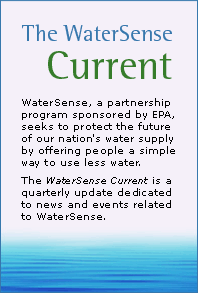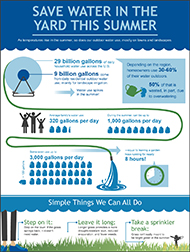The WaterSense Current Summer 2014
Issue XXXI, Summer 2014
Americans Save 757 Billion Gallons of Water With WaterSense
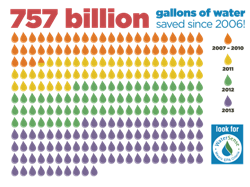
The U.S. Government Accountability Office recently reported that 40 out of 50 state water managers expect water shortages under average conditions in some portion of their state over the next decade. WaterSense partners know the importance of protecting water supplies for future generations. In addition to promoting WaterSense labeled products, they have helped Americans save $14.2 billion in water and energy costs and 757 billion gallons of water since the program's inception in 2006. That's enough water to supply all homes in the United States for 26 days!
By the end of 2013, more than 10,900 different models of toilets, faucets, showerheads, flushing urinals, and weather-based irrigation controllers had earned the WaterSense label. In addition to water savings, WaterSense labeled products also helped reduce the amount of energy needed to heat, pump, and treat water by 101 billion kilowatt hours, enough to supply more than 9.3 million homes with power for a year. These savings equate to 37 million metric tons of greenhouse gas emissions, equivalent to planting nearly 941 million trees.
Builder partners had constructed a total of 316 WaterSense labeled new homes by the end of 2013. These single-family homes save 50,000 gallons of water compared to traditional homes. Homeowners who invested in WaterSense labeled models have saved 16 million gallons of water combined per year. Many of these homes have yards designed using the WaterSense Water Budget tool, which uses local climate conditions to help builders create beautiful landscapes that require less water and maintenance.
WaterSense's success in 2013 would not have been possible without its nearly 3,000 partners and certified professionals. Working with the U.S. Environmental Protection Agency (EPA), these utilities, government agencies, nonprofit organizations, manufacturers, retailers, distributors, builders, and irrigation professionals certified through WaterSense labeled programs, have helped consumers save water, energy, and money with WaterSense.
Throughout 2013, WaterSense continued to spread the word about water efficiency, reaching 13,000 Facebook and Twitter followers by the end of the year. In traditional media, WaterSense achieved more than 13,000 media "hits" resulting in more than 2 billion earned media impressions.
WaterSense further grew its marketing and outreach efforts by launching the Sprinkler Spruce-Up campaign in May 2013. The campaign encouraged consumers to "inspect, connect, direct, and select" their sprinklers to save water during the warm-weather watering season. Water efficiency also got cooking indoors in 2013 with pre-rinse spray valves becoming the first commercial kitchen product to be able to earn the WaterSense label. WaterSense labeled pre-rinse spray valves can save a typical commercial kitchen more than 7,000 gallons of water per year, equivalent to the amount of water needed to wash nearly 5,000 racks of dishes.
Learn more about WaterSense's milestones.
National Climate Assessment Highlights Water Supply Challenges
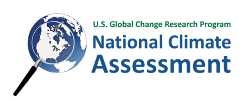
There is a saying: the climate is what you expect; the weather is what you get. In describing the current and future impacts of climate change in the United States, the third National Climate Assessment![]() released in early May updates the view of what we should expect with regards to climate change. And looking at the weather we have had across the United States recently, it appears that we might be getting a preview of our future normal.
released in early May updates the view of what we should expect with regards to climate change. And looking at the weather we have had across the United States recently, it appears that we might be getting a preview of our future normal.
A deep drought persists across California, the Southwest, Texas, and Oklahoma. In the upper Midwest, many communities have seen record rainfall and flooding. It will come as no surprise that the National Climate Assessment shows that Americans are already feeling the effects of extreme weather in many regions of the country.
The report looks at different weather trends, including temperature, precipitation, and extreme weather, and suggests that the intensity of rainfall during storm events will increase, as well the duration of dry spells. Sections also focus on the risks facing different sectors, including water and agriculture, and impacts on urban areas and rural communities.
Because it's important for everybody to understand what climate change will mean for them where they live, the sections describing impacts in specific regions of the country should be of particular interest. From increased fire risk and drought to sea level rise and more intense storms, you can also find out what climate change looks like for Americans on the front lines through a series of short videos![]() produced to support the assessment.
produced to support the assessment.
By understanding current and future impacts, we will be able to better help our communities adapt to meet future challenges. WaterSense and efficient water use can be a key component of community adaptation strategies to address water shortages now and in the future.
Irrigation Association Shares 10 Tips to Show Your Water Smarts Outdoors
The Irrigation Association (IA)—EPA's inaugural WaterSense Professional Certifying Organization Partner of the Year—is reminding homeowners to use water wisely while maintaining their lawns during Smart Irrigation Month![]() this July. From what to plant to when to water, following are 10 tips based on IA's advice for saving water outdoors this summer, as well as ways WaterSense can help you get there.
this July. From what to plant to when to water, following are 10 tips based on IA's advice for saving water outdoors this summer, as well as ways WaterSense can help you get there.
Plant With a Purpose
- Landscape to suit your lot. Designing a water-smart landscape with regionally appropriate plants creates a low-maintenance lawn, allowing you more time to sit back and enjoy the view. Check out our Water-Smart Landscape Photo Gallery for local plant selections that are easy on the eyes.
- Let it breathe. Soil can become compacted during home construction or from normal foot traffic. Aerating your soil with a simple lawn aerator can increase the infiltration of water into the ground, improving water flow to the plant's root zone and reducing water runoff.
Irrigate Intelligently
- Get in control. Consider "smart" controls that automatically adjust watering. Backed by independent certification, WaterSense labeled irrigation controllers act like a thermostat for your sprinkler system by telling it when and how much to water using local weather and landscape data.
- Search for savings. Many water utilities offer rebates for certain water-efficient products. Before finalizing your new irrigation system, consult with your local water provider or use the WaterSense Rebate Finder to find an irrigation controller rebate near you.
Water Wisely
- Water only when needed. No matter what kind of yard or landscape you have, timing is everything. Avoid watering in the middle of the day when the hot sun will evaporate much of the water before it can get to thirsty plants.
- Get in the zone. Schedule each individual zone in your irrigation system to account for the type of sprinkler, sun or shade exposure, and type of plants and soil in the specific area. The same watering schedule rarely applies to all zones in the system.
Maintain and Upgrade Your System
- Inspect for leaks. A leak about as small as the tip of a ballpoint pen (i.e., 1/32nd of an inch) can waste about 6,300 gallons of water per month.
- Adjust sprinkler heads. Lots of water is wasted by poorly designed and neglected sprinkler systems that spray sidewalks, driveways, and the street. Set sprinklers to keep the water on the landscape and off the pavement.
Work With an Irrigation Professional
- Get to know your contractor. When hiring contractors to install and service your irrigation system and maintain your yard, WaterSense recommends asking three simple questions to gauge their skills and experience.
- Go with a pro. For optimal irrigation efficiency, look for an irrigation professional certified by a WaterSense labeled program to ensure your system uses the right amount of water for a healthy, beautiful, water-smart landscape.
Learn more about IA's Smart Irrigation Month![]() and WaterSense's tips for saving water outdoors.
and WaterSense's tips for saving water outdoors.
California Golf Resort Scores an Ocean of Outdoor Water Savings
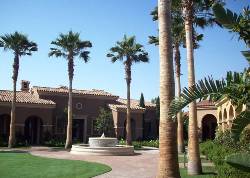
The Resort at Pelican Hill
A recent survey by TripAdvisor found that 79 percent of travelers place importance on properties implementing eco-friendly practices, and 85 percent of U.S. hoteliers indicate that they currently have green practices in place, including more than 25 WaterSense H2Otel Challenge participants. The Resort at Pelican Hill in Newport Beach, California, is catering to green-minded golfers seeking an environmentally responsible course.
With preserved land accounting for more than 99 percent of the resort's total irrigable acres and an ocean view attracting visitors, water conservation goes hand in hand with its environmental stewardship efforts to protect the area's most valuable asset—the Pacific Ocean. From 2009 to 2010, the golf getaway saved more than 48 million gallons of water with outdoor best management practices like those found in WaterSense at Work.
Pelican Hill's 100-acre landscape is maintained by ValleyCrest Landscape Companies, Inc., which oversaw five landscaping companies conducting the initial landscape and irrigation system installation. In 2010, ValleyCrest refined the resort's irrigation components and implemented other measures to make the system more water-efficient while maintaining the landscape's beauty. In just one year, the resort saved $75,000 with WaterSense labeled controllers, drip irrigation, high-efficiency rotating nozzles, drought-tolerant plant selections, turf reduction, recycled municipal water, rainwater collection for golf course irrigation, and regular irrigation system maintenance.
In 2009, drought-tolerant plants were incorporated throughout the property, and turf was strategically limited to 6 to 8 percent of the site where events such as weddings take place. What's more, 90 percent of the landscape is irrigated with recycled water purchased through WaterSense partner Irvine Ranch Water District's (IRWD's) Water Recycling Program. To increase these water savings in 2010, ValleyCrest separated tree species from turf into micro-zones based on their watering requirements and replaced hundreds of high water-using flowers with succulents. That same year, the Professional Landcare Network (PLANET) honored ValleyCrest with a PLANET Merit Award for achieving landscape water efficiency while maintaining aesthetics at Pelican Hill.
The resort's WaterSense labeled controllers use the Internet to access local weather data and landscape conditions to water only when plants need it. They also generate regular reports and send automatic alerts to operations and maintenance personnel based on the system's flow sensors. These remote capabilities allow staff to adjust the system from their computers, reducing labor costs.
A water management system of five underground rainwater cisterns holding 5 million gallons of water captures storm runoff, which is used to irrigate Pelican Hill's golf courses. A full-time water quality manager monitors and maintains the system to ensure that it saves more than 50 million gallons of water per year; reduces the amount of debris and contaminants in the water; and successfully captures and recycles runoff.
Learn how other resorts are taking the "guest" work out of saving water through the WaterSense H2Otel Challenge.
Texas Tween Inspires Landscape Company to Go Green (With Less Blue)

John (left) and Dyllan (right) Taylor
with John’s 2013 WaterSense Irrigation
Partner of the Year award
Certified irrigation professional John Taylor goes above and beyond to promote WaterSense labeled products and water-efficient practices, which in part earned him the 2013 WaterSense Irrigation Partner of the Year award. But it was a simple question asked by his curious daughter that made the president of Taylor Irrigation Service, Inc., in Houston, Texas, put outdoor water efficiency at the forefront of his business model.
In 2011, John had been in the irrigation industry for nearly 20 years, and though he valued water conservation, he mostly sold standard irrigation systems. A movie night out to see "Rango" with his then-nine-year-old daughter, Dyllan Taylor, changed his perspective. The flick focuses on a group of small animals in a desert town who go on a journey to discover why their water supply ran dry. At the end of their voyage, they discover their water pipe capped and sprinkler systems running during the day on lush green lawns in arid Las Vegas.
As they left the theater, Dyllan asked, "Dad, is that true? Is irrigation taking water from people that need it to live?" John realized this view of irrigation had made water conservation a personal issue for his daughter, and he needed to make a change to his business model to reflect his own commitment to water efficiency. With this in mind, he took a leap and started to exclusively offering weather-based irrigation controllers, including WaterSense labeled models. These controllers act like a thermostat for your sprinkler system, telling it when and how much to water using local weather and landscape conditions.
Although weather-based systems can cost more upfront than standard systems, John finds showing his customers the return on investment and the healthier, more sustainable landscapes they gain makes WaterSense the obvious choice. "When you sell WaterSense labeled products, everyone wins: the homeowner saves money; the water purveyor saves water; the landscape is healthier; and the local municipality and state conserve a precious resource that puts less of a burden on the infrastructure," John says.
John notes that these smart irrigation controllers take knowledge to program and require calibration and fine-tuning. Irrigation professionals certified by a WaterSense labeled program understand how to properly set up the system and make adjustments so it works correctly for your landscape. John monitors his customers' water bills after updating their irrigation system to WaterSense labeled models and finds that the money saved from the 35 to 45 percent reduction in water consumption pays for the controller in as little as three years.
In addition to helping customers save with his water-smart business model, John has also made his water-savvy daughter proud. "The 2013 WaterSense Irrigation Partner of the Year award has not only recognized my irrigation efforts; it has recognized hard work, communication, and has shown that asking a question can lead to significant change," John says.
Learn more about John Taylor![]() and his efforts to promote water-efficient landscape irrigation.
and his efforts to promote water-efficient landscape irrigation.
Partner Profile: KB Home
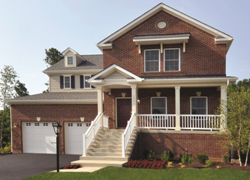
JZeroHouse 2.0 home in Waldorf, Maryland
(Photo Courtesy KB Home)
Three-time WaterSense Builder Partner of the Year KB Home continues to break new ground on its already strong foundation of water-efficient new home construction. Since partnering with WaterSense in 2010, KB Home has built more than 260 WaterSense labeled new homes in four states across the country.
KB Home constructed its first WaterSense labeled new home in northern California, and this year is coming full circle with the planned construction of four new communities in the Sacramento region, where homes will all be constructed to meet the WaterSense new home specification. KB Home's two newest communities in Los Angeles, Asher and Skylar at Playa Vista, also have homes that have earned the WaterSense label and achieved LEED® Platinum through the U.S. Green Building Council's rating system.
Water efficiency plays a critical role in KB Home's overall sustainability initiatives, and the builder is continuing to explore new technologies that complement its water conservation efforts. In February 2014, KB Home expanded its ZeroHouse 2.0 program and introduced its first ever "Double ZeroHouse,"![]() a WaterSense labeled new home designed to achieve net-zero energy status and zero freshwater irrigation use by a family of four or more. The Lancaster, California, home is also the first KB home to receive triple EPA certifications for meeting WaterSense, ENERGY STAR®, and Indoor airPlus® criteria.
a WaterSense labeled new home designed to achieve net-zero energy status and zero freshwater irrigation use by a family of four or more. The Lancaster, California, home is also the first KB home to receive triple EPA certifications for meeting WaterSense, ENERGY STAR®, and Indoor airPlus® criteria.
KB Home estimates that the new recycled drainwater components of the Double ZeroHouse, combined with the water-saving features of the WaterSense specification, can save 150,000 gallons of water each year when compared to a typical resale home and landscaping—a reduction of approximately 70 percent.
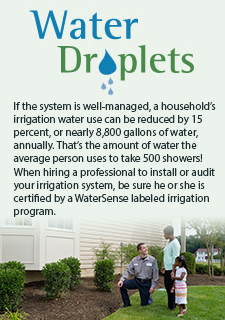
"As we continue to expand the program to more KB Home divisions nationwide, our homebuyers are becoming increasingly aware that the WaterSense label and other components of the ZeroHouse provide huge benefits to the planet, as well as their wallet," says Dan Bridleman, senior vice president of sustainability, technology and strategic sourcing for KB Home. "Our buyers are proud to own KB homes they know will not only lessen their environmental impact but will save them money."
Along with constructing new homes, KB Home consistently promotes WaterSense and water efficiency through external promotional outlets and internal programs. KB Home employees receive training materials and sales tools to educate homebuyers about the benefits of a home with WaterSense labeled products inside and out.
Learn more about KB Home![]() and its efforts to promote water-efficient homes.
and its efforts to promote water-efficient homes.



